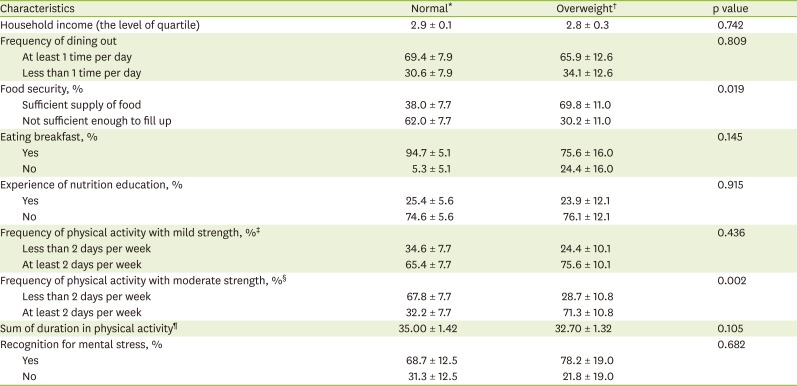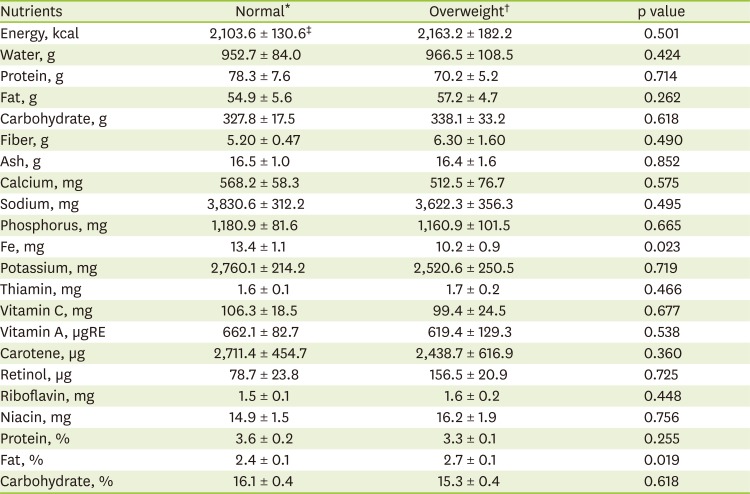1. Halperin JM, Bedard AC, Curchack-Lichtin JT. Preventive interventions for ADHD: a neurodevelopmental perspective. Neurotherapeutics. 2012; 9:531–541. PMID:
22692794.

2. Pagoto SL, Curtin C, Lemon SC, Bandini LG, Schneider KL, Bodenlos JS, Ma Y. Association between adult attention deficit/hyperactivity disorder and obesity in the US population. Obesity (Silver Spring). 2009; 17:539–544. PMID:
19131944.

3. Millichap JG. Etiologic classification of attention-deficit/hyperactivity disorder. Pediatrics. 2008; 121:e358–e365. PMID:
18245408.

4. Niederhofer H. Association of attention-deficit/hyperactivity disorder and celiac disease: a brief report. Prim Care Companion CNS Disord. 2011; 13:PCC.10br01104. PMID:
21977364.
5. Melamed I, Heffron M. Attention deficit disorder and allergic rhinitis: are they related? J Immunol Res. 2016; 2016:1596828. PMID:
27872863.

6. Hennissen L, Bakker MJ, Banaschewski T, Carucci S, Coghill D, Danckaerts M, Dittmann RW, Hollis C, Kovshoff H, McCarthy S, Nagy P, Sonuga-Barke E, Wong IC, Zuddas A, Rosenthal E, Buitelaar JK; ADDUCE consortium. Cardiovascular effects of stimulant and non-stimulant medication for children and adolescents with ADHD: a systematic review and meta-analysis of trials of methylphenidate, amphetamines and atomoxetine. CNS Drugs. 2017; 31:199–215. PMID:
28236285.

7. Parisi P, Villa MP, Donfrancesco R, Miano S, Paolino MC, Cortese S. Could treatment of iron deficiency both improve ADHD and reduce cardiovascular risk during treatment with ADHD drugs? Med Hypotheses. 2012; 79:246–249. PMID:
22632845.

8. Angriman M, Bruni O, Cortese S. Does restless legs syndrome increase cardiovascular risk in attention-deficit/hyperactivity disorder? Med Hypotheses. 2013; 80:39–42. PMID:
23111202.

9. Davis C, Levitan RD, Smith M, Tweed S, Curtis C. Associations among overeating, overweight, and attention deficit/hyperactivity disorder: a structural equation modelling approach. Eat Behav. 2006; 7:266–274. PMID:
16843230.

10. Pagoto SL, Curtin C, Bandini LG, Anderson SE, Schneider KL, Bodenlos JS, Ma Y. Weight loss following a clinic-based weight loss program among adults with attention deficit/hyperactivity disorder symptoms. Eat Weight Disord. 2010; 15:e166–e172. PMID:
21150252.

11. Cortese S, Peñalver CM. Comorbidity between ADHD and obesity: exploring shared mechanisms and clinical implications. Postgrad Med. 2010; 122:88–96. PMID:
20861592.

12. Cortese S, Angriman M. Attention-deficit/hyperactivity disorder, iron deficiency, and obesity: is there a link? Postgrad Med. 2014; 126:155–170. PMID:
25141253.

13. Cortese S, Ramos Olazagasti MA, Klein RG, Castellanos FX, Proal E, Mannuzza S. Obesity in men with childhood ADHD: a 33-year controlled, prospective, follow-up study. Pediatrics. 2013; 131:e1731–e1738. PMID:
23690516.

14. Novotny R, Nigg CR, Li F, Wilkens LR. Pacific kids DASH for health (PacDASH) randomized, controlled trial with DASH eating plan plus physical activity improves fruit and vegetable intake and diastolic blood pressure in children. Child Obes. 2015; 11:177–186. PMID:
25671796.

15. Kim EY. Association between drinking water intake, dietary habits and mental health in high school adolescents [master's thesis]. Seoul: Kyung Hee University;2015.
16. Bleich SN, Jones-Smith J, Jones H, O'Hara M, Rutkow L. The voices for healthy kids campaign and US State Legislation to prevent childhood obesity. Am J Public Health. 2016; 106:436–439. PMID:
26794169.

17. Schwartz MB, Schneider GE, Choi YY, Li X, Harris J, Andreyeva T, Hyary M, Highsmith Vernick N, Appel LJ. Association of a community campaign for better beverage choices with beverage purchases from supermarkets. JAMA Intern Med. Forthcoming. 2017.

18. Yu CJ, Du JC, Chiou HC, Feng CC, Chung MY, Yang W, Chen YS, Chien LC, Hwang B, Chen ML. Sugar-sweetened beverage consumption is adversely associated with childhood attention deficit/hyperactivity disorder. Int J Environ Res Public Health. 2016; 13:E678. PMID:
27384573.

19. Hassapidou M, Fotiadou E, Maglara E, Papadopoulou SK. Energy intake, diet composition, energy expenditure, and body fatness of adolescents in northern Greece. Obesity (Silver Spring). 2006; 14:855–862. PMID:
16855195.

20. Kwon MK. A study on characteristics of nutrient intakes, food Intakes and food habits of underweight adolescents [master's thesis]. Asan: Soonchunhyang University;2007.
21. Krummel DA, Seligson FH, Guthrie HA. Hyperactivity: is candy causal? Crit Rev Food Sci Nutr. 1996; 36:31–47. PMID:
8747098.

22. Korea Centers for Disease Control and Prevention. Guidelines for utilization of raw data from the fifth Korea National Health and Nutrition Examination Survey (2010–2012). Cheongwon: Korea Centers for Disease Control and Prevention;2013.
23. Rural Development Administration, National Rural Resources Development Institute (KR). Food composition table. 7th ed. Suwon: Rural Development Administration, National Rural Resources Development Institute;2006.
24. Elliott SA, Truby H, Lee A, Harper C, Abbott RA, Davies PS. Associations of body mass index and waist circumference with: energy intake and percentage energy from macronutrients, in a cohort of Australian children. Nutr J. 2011; 10:58. PMID:
21615883.

25. Ministry of Health and Welfare (KR). The Korean Nutrition Society. Dietary reference intakes for Koreans 2015. Sejong: Ministry of Health and Welfare;2016.
26. Pinhas-Hamiel O, Newfield RS, Koren I, Agmon A, Lilos P, Phillip M. Greater prevalence of iron deficiency in overweight and obese children and adolescents. Int J Obes Relat Metab Disord. 2003; 27:416–418. PMID:
12629572.

27. Erikson KM, Jones BC, Beard JL. Iron deficiency alters dopamine transporter functioning in rat striatum. J Nutr. 2000; 130:2831–2837. PMID:
11053528.

28. Shoham S, Youdim MB. Iron involvement in neural damage and microgliosis in models of neurodegenerative diseases. Cell Mol Biol (Noisy-le-grand). 2000; 46:743–760. PMID:
10875437.
29. Simpson IA, Ponnuru P, Klinger ME, Myers RL, Devraj K, Coe CL, Lubach GR, Carruthers A, Connor JR. A novel model for brain iron uptake: introducing the concept of regulation. J Cereb Blood Flow Metab. 2015; 35:48–57. PMID:
25315861.

30. Salvador Castell G, Serra-Majem L, Ribas-Barba L. What and how much do we eat? 24-hour dietary recall method. Nutr Hosp. 2015; 31(Suppl 3):46–48. PMID:
25719770.
31. Lucas EA, Li W, Peterson SK, Brown A, Kuvibidila S, Perkins-Veazie P, Clarke SL, Smith BJ. Mango modulates body fat and plasma glucose and lipids in mice fed a high-fat diet. Br J Nutr. 2011; 106:1495–1505. PMID:
21733317.

32. Perry CS 3rd, Rapinett G, Glaser NS, Ghetti S. Hydration status moderates the effects of drinking water on children's cognitive performance. Appetite. 2015; 95:520–527. PMID:
26271221.

33. Maffeis C, Tommasi M, Tomasselli F, Spinelli J, Fornari E, Scattolo N, Marigliano M, Morandi A. Fluid intake and hydration status in obese vs normal weight children. Eur J Clin Nutr. 2016; 70:560–565. PMID:
26463726.

34. Meinzer MC, Lewinsohn PM, Pettit JW, Seeley JR, Gau JM, Chronis-Tuscano A, Waxmonsky JG. Attention-deficit/hyperactivity disorder in adolescence predicts onset of major depressive disorder through early adulthood. Depress Anxiety. 2013; 30:546–553. PMID:
23424020.










 PDF
PDF ePub
ePub Citation
Citation Print
Print



 XML Download
XML Download